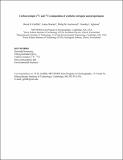| dc.contributor.author | Griffith, David Richmond | |
| dc.contributor.author | Wacker, Lukas | |
| dc.contributor.author | Gschwend, Philip M. | |
| dc.contributor.author | Eglinton, Timothy I. | |
| dc.date.accessioned | 2013-03-15T18:05:12Z | |
| dc.date.available | 2013-03-15T18:05:12Z | |
| dc.date.issued | 2012-10 | |
| dc.date.submitted | 2012-08 | |
| dc.identifier.issn | 0951-4198 | |
| dc.identifier.issn | 1097-0231 | |
| dc.identifier.uri | http://hdl.handle.net/1721.1/77916 | |
| dc.description.abstract | RATIONALE:
Steroids are potent hormones that are found in many environments. Yet, contributions from synthetic and endogenous sources are largely uncharacterized. The goal of this study was to evaluate whether carbon isotopes could be used to distinguish between synthetic and endogenous steroids in wastewater and other environmental matrices.
METHODS:
Estrogens and progestogens were isolated from oral contraceptive pills using semi-preparative liquid chromatography/diode array detection (LC/DAD). Compound purity was confirmed by gas chromatography/flame ionization detection (GC/FID), gas chromatography/time-of-flight mass spectrometry (GC/TOF-MS) and liquid chromatography/mass spectrometry using negative electrospray ionization (LC/ESI-MS). The 13C content was determined by gas chromatography/isotope ratio mass spectrometry (GC/IRMS) and 14C was measured by accelerator mass spectrometry (AMS).
RESULTS:
Synthetic estrogens and progestogens are 13C-depleted (δ13Cestrogen = –30.0 ± 0.9 ‰; δ13Cprogestogen = –30.3 ± 2.6 ‰) compared with endogenous hormones (δ13C ~ –16 to –26 ‰). The 14C content of the majority of synthetic hormones is consistent with synthesis from C3 plant-based precursors, amended with 'fossil' carbon in the case of EE2 and norethindrone acetate. Exceptions are progestogens that contain an ethyl group at carbon position 13 and have entirely 'fossil' 14C signatures.
CONCLUSIONS:
Carbon isotope measurements have the potential to distinguish between synthetic and endogenous hormones in the environment. Our results suggest that 13C could be used to discriminate endogenous from synthetic estrogens in animal waste, wastewater effluent, and natural waters. In contrast, 13C and 14C together may prove useful for tracking synthetic progestogens. Copyright © 2012 John Wiley & Sons, Ltd. | en_US |
| dc.description.sponsorship | Martin Family Society of Fellows for Sustainability | en_US |
| dc.description.sponsorship | United States. Environmental Protection Agency (STAR Graduate Fellowship FP-91713401) | en_US |
| dc.language.iso | en_US | |
| dc.publisher | Wiley Blackwell | en_US |
| dc.relation.isversionof | http://dx.doi.org/10.1002/rcm.6385 | en_US |
| dc.rights | Creative Commons Attribution-Noncommercial-Share Alike 3.0 | en_US |
| dc.rights.uri | http://creativecommons.org/licenses/by-nc-sa/3.0/ | en_US |
| dc.source | Other Repository | en_US |
| dc.title | Carbon isotopic (C-13 and C-14) composition of synthetic estrogens and progestogens | en_US |
| dc.type | Article | en_US |
| dc.identifier.citation | Griffith, David R. et al. “Carbon Isotopic (13 C and 14 C) Composition of Synthetic Estrogens and Progestogens.” Rapid Communications in Mass Spectrometry 26.22 (2012): 2619–2626. | en_US |
| dc.contributor.department | Massachusetts Institute of Technology. Department of Civil and Environmental Engineering | en_US |
| dc.contributor.department | Massachusetts Institute of Technology. Department of Civil and Environmental Engineering | en_US |
| dc.contributor.department | Woods Hole Oceanographic Institution | en_US |
| dc.contributor.mitauthor | Griffith, David Richmond | |
| dc.contributor.mitauthor | Gschwend, Philip M. | |
| dc.relation.journal | Rapid Communications in Mass Spectrometry | en_US |
| dc.eprint.version | Author's final manuscript | en_US |
| dc.type.uri | http://purl.org/eprint/type/JournalArticle | en_US |
| eprint.status | http://purl.org/eprint/status/PeerReviewed | en_US |
| dspace.orderedauthors | Griffith, David R.; Wacker, Lukas; Gschwend, Philip M.; Eglinton, Timothy I. | en |
| dc.identifier.orcid | https://orcid.org/0000-0002-9497-4492 | |
| mit.license | OPEN_ACCESS_POLICY | en_US |
| mit.metadata.status | Complete | |
